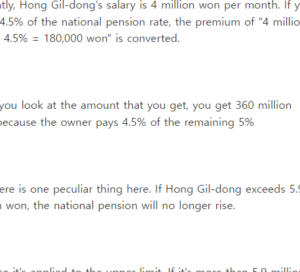Hello, I’m the economic trend blogger, “Instar Kilograms.” Today, we’re going to look at the four major premium rates that go out of your salary every time. Let’s calculate together how much goes out of your salary into your premium. 사대보험 계산기
calculation of the national pension rate
Let’s check the national pension rate, which is the most representative and the most common.
Basically, the basic rate of the national pension is 9 percent of the earned income. But if you’re not a business operator, only 50 percent of the 9 percent will be covered by the worker
So, the standard applied as a standard for salary is set at 4.5%.
Then let’s make a simple calculation.

Currently, Hong Gil-dong’s salary is 4 million won per month. If you apply 4.5% of the national pension rate, the premium of “4 million won X 4.5% = 180,000 won” is converted.
But if you look at the amount that you get, you get 360 million won, because the owner pays 4.5% of the remaining 5%
But there is one peculiar thing here. If Hong Gil-dong exceeds 5.9 million won, the national pension will no longer rise.
Because it’s applied to the upper limit. If it’s more than 5.9 million, you can think of paying the same.
Calculation of employment insurance rates
Let’s see how the rates of employment insurance are established. First of all, you know the reason for paying those costs, but it’s the amount that you have to pay in order to get unemployment benefits
Generally, the rate applied is 1.8%, and employment insurance also covers 50% with the employer, so the amount set for the worker is 1.8% of the earned income.
If you’re paid 4 million won a month, you’re paying 4 million won x 1.8% = 72,000 won / 2 = 36,000 won, but this also changes depending on the type of business
premium rate
a worker
business owner
unemployment benefits
0.9%
0.9%
Employment stability and vocational competency development projects
Companies with less than 150 employees
–
0.25%
Companies with 150 or more employees eligible for priority support
–
0.45%
Companies with 150 or more to less than 1000 employees
–
0.65%
Companies with 1,000 or more employees, national local governments
–
0.85%
First of all, companies eligible for support: 500 or less manufacturing workers and 300 or less construction workers
As you can see in the table above, in the case of an employment safety vocational competency development project, the amount paid may be 0 won depending on the company’s full-time workers.
health/medical care
In the case of health/medical insurance, it is calculated differently depending on the local subscriber and the workplace subscriber. Since we check based on workers, let’s look at how workers apply it.
For office workers, a rate of 7.09% of their income is applied. However, health insurance also pays 5 to 5 with the employer, so 7.09/2 = 3.545%.
However, there is an additional long-term care insurance premium. In the case of long-term care insurance, the health insurance premium x long-term care premium rate of 0.9082% / 7.09% is applied, so it does not account for a large portion.
If Hong Gil-dong receives a monthly salary of 5 million won, he will have to pay 5 million won X 7.09% / 2 = 177,250 won, and if he applies long-term care, he will pay an additional 23,000 won.
Calculation of industrial accident insurance premium rate
Finally, in the case of industrial accidents, there is no burden on workers. This is because the company pays 100% of the burden. In the case of companies, rates are applied depending on the type of business, and if they are certified for risk assessment, the rates will fall a little more.
Please note that the industrial accident rate will fall even if the safety and health management system is certified as the Act on the Punishment of Serious Disasters with 5 or more employees is applied.
1) Industrial accident insurance rate table by industry
Industry classification
premium rate
Industry classification
premium rate
1. Mining
5.76%~18.56%
6. forestry
5.86%
2. the manufacturing industry
0.66%~2.46%
7. fishing industry
2.76%
3. Electricity gas and water multiplier
0.76%
8. agriculture
2.06%
4. the construction industry
3.56%
9. Other businesses
0.66%~0.96%
5. the transportation, warehousing, and telecommunications industries
0.86%~1.86%
10. the financial and insurance industries
0.56%